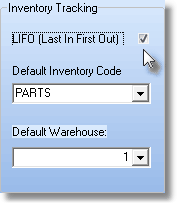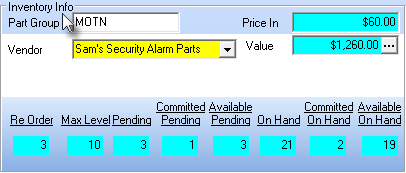| • | Now there are a few other Maintenance items which should be reviewed and more importantly, understood. |
| • | ADI is a wholesale inventory and materials provider to more than 80,000 installer contractors in North America - many of whom are Security System installers. |
| • | It is often necessary to pass equipment from one Warehouse, Technician, Truck, etc. to another and the Warehouse Transfer Form allows you to accurately track those movements. |
| 5. | Edit Warehouse Inventory Levels - Explains how to (Re-)Set the rules for Reordering Inventory items, and to adjust these numbers based on the actual quantities found while taking a physical Inventory. |
| 2. | LIFO - Last In / First Out |
| • | However, from an accounting standpoint, you may want to alter this default behavior by having that Price In Value re-set, based on the most recent Cost paid on an Invoice for the Re-Purchase of each Inventory Item. |
| • | This automatic Price In Value (Cost) re-set - based on the most recent price paid (Cost) - is referred to as Last In - First Out, or LIFO for short. |

Check LIFO (Last In First Out)
| • | Thereafter, whenever an Inventory Item is Purchased or Sold, this continuously updated (LIFO) Value is the Value that is used in the associated General Ledger System transactions. |
| • | This valuation drift occurs over time as Costs are reset but the previous history and timing of those Cost resets is unclear. |
| • | A different approach in establishing and maintaining the Value of the Inventory is to continuously Average the Cost of Inventory so that all Price (Cost) changes are taken into consideration whenever the Value of an Inventory Item is reported. |
| • | Once implemented, the Inventory Cost Averaging Calculation records each Purchase of an Inventory Item, the specific Price (Cost) paid for that item, and the Quantity of each Inventory Item that was Purchased. |
| • | Inventory Cost Averaging Calculation - Inventory Item that is currently "in stock" is determined by adding the Quantity of new Inventory Purchases and subtracting the Quantity of new Inventory Sales. |
| ▪ | This table contains the following information: |
| e) | Total Cost Paid for all of the Inventory Items that are currently On-Hand |
| • | This example of the Average Inventory Cost table shows how it is accessed and updated as Inventory is Purchased and Sold: |
|
Quantity
|
Unit Price
|
Total Price
|
Count
|
Total Cost
|
Avg. Cost
|
1st Purchase
|
1
|
$3.00
|
$3.00
|
1
|
$3.00
|
$3.00
|
2nd Purchase
|
2
|
$3.00
|
$6.00
|
3
|
$9.00
|
$3.00
|
3rd Purchase
|
3
|
$1.00
|
$3.00
|
6
|
$12.00
|
$2.00
|
1st Sale
|
-1
|
|
|
5
|
$10.00
|
$2.00
|
4th Purchase
|
1
|
$4.00
|
$4.00
|
6
|
$14.00
|
$2.33
|
2nd Sale
|
-1
|
|
|
5
|
$11.67
|
$2.33
|
Sample Average Cost Valuation Calculations
| • | When an Invoice for the Purchase of an Inventory Item is entered, a corresponding entry is made in this Average Inventory Cost table with: |
| d) | A new Count is calculated by adding the Quantity that was just Purchased to the previous Count. |
| e) | The new Total Cost Paid is calculated by adding the Total Price Paid to the previous Total Cost |
| f) | The Average Cost is re-calculated by dividing the new Total Cost be the new Count |
| • | When a Sale of an Inventory Item is entered, an entry is made in this Average Inventory Cost table with: |
| a) | The Quantity that was Sold |
| b) | A new Count is calculated by subtracting the Quantity Sold from the previous Count. |
| c) | The Total Cost Paid which is recalculated by subtracting the result of the Quantity Sold multiplied by the previously calculated Average Cost. |
| d) | The Average Cost is re-calculated by dividing the new Total Cost be the new Count |
| • | Implementing the Average Inventory Cost internally maintained calculation (Inventory Valuation methodology) for tracking the Value of Inventory Items within the General Ledger System. |
| 1. | If the AverageCostInventory option set to True ("T"), Inventory Valuation will be set based on the Average Cost paid for an Inventory Item versus (whatever was) the previously selected Inventory Valuation method. |
| ▪ | When AverageCostInventory is set to True ("T"), setting the Inventory Valuation to the Average Cost paid for an Inventory Item, if LIFO (Last In/First Out) was the selected Inventory Valuation Method, it will be turned off (LIFO will be Un-Checked) automatically. |
| 2. | Once the AverageCostInventory option set to True ("T"), from the Main Menu Select the Maintenance Menu and Choose the Inventory Tracking sub-menu, then Select the Calculate Inventory Item Average Cost option. |
| □ | Summary of the effects on the Sale-Purchase Item Form as they relate to these Inventory Valuation Methods: |
| • | The Price In for an Inventory Item - regardless of whether it is used as Both a Purchase and a Sale, or just a Purchase - will be the default Price inserted for the Inventory Item when entering a Bill. |

| • | How and whether the Price In and/or Value fields will be displayed within the Inventory Info box on the Sale-Purchase Item Form is based on which Inventory Valuation Method has been elected. The differences in how these Price In and/or Value fields are displayed are as follows: |
| • | Price In - This will be displayed as a normal mandatory field on the Sale-Purchase Item Form if this is an Inventory Item and the Average Inventory Cost Inventory Valuation Method has not be elected. |
| ▪ | When the Price In Inventory Valuation Method is in effect, the contents of the Price In field will remain unchanged unless that field is modified manually. |

Inventory Info box - LIFO or Price In Inventory Valuation Method selected
| • | LIFO - If the LIFO Inventory Valuation Method is in effect, the contents of this Price In field will be updated each time another Inventory Item of this type is Purchased with the Cost re-set to the most current Price that was Paid. |
| • | Price In (Average Cost of this Item) - If the Average Inventory Cost Inventory Valuation Method is in effect, this is a system maintained field which is updated, as needed, using the Calculate Average Inventory procedure. |

Inventory Info box - Average Cost Inventory Valuation Method selected
| • | Value (total value of what is actually 'in-stock' On Hand for this Inventory Item) - If the Average Inventory Cost Inventory Valuation Method is in effect, this will be a system maintained field which is also updated, as needed, using the Calculate Average Inventory process. |







